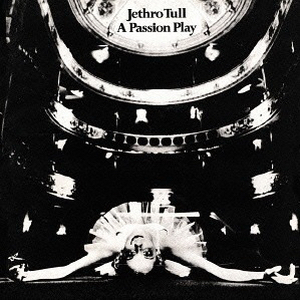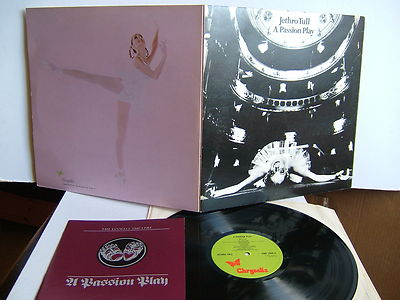During the years between my senior year in high school and my sophomore year of college Jethro Tull went from being an important band in my life to, by far, the most important (also on the short list during this formative era were Pink Floyd, King Crimson, Neil Young, Rush, Black Sabbath, and some of the other usual suspects who were there before, during, and after; they’re with me still.) So it stands to reason that I’d have a lingering, sentimental fondness for prog rock, in general, and Jethro Tull, in particular. But no, I remain as resolute as ever as many of the opinions I held dear as a teenager: this music is at once amazing and important. As fans, certain works appear in our lives at seemingly the perfect moment; sometimes it’s a matter of something that heals or inspires when we need it most, other times a particular piece offers itself when we are in a position to not only fully appreciate it, but become obsessed to the extent that we’re both willing and able to lend the time and attention necessary to allow it into our hearts and minds.
In any event, I’ve spent the decades since writing about it an awful lot, and I’ve certainly spilled some (mostly digital) ink on prog rock (in general) and Jethro Tull (in particular). Indeed, I’ve written on more than one occasion about A Passion Play. Suffice it to say, it’s unlikely I’ll ever tire of discussing and celebrating this music, but I write about it less often than I once did — for a variety of reasons, principle among them that I have lent my focus, of late, to work that’s quite different, yet similar in its way. In any event, it’s all of one piece when it’s coming from a place of passion and play (SWIDT?).
And so, when invited to contribute an appreciation for this album, on the occasion of its fiftieth anniversary for a special Jethro Tull-themed issue of Record Collector magazine, what could I say but Once more unto the breach, dear friends, once more.
When it comes to a band with as many iterations—and albums—as Jethro Tull (the ironically titled This Was dropped in 1968 and Ian Anderson & Co. are still active, more than five decades on), opinions will vary widely about their greatest work, best line-up, etc. But it’s possible that no album from their prime polarizes fans quite like 1973’s A Passion Play. This one took the dialed-to-11 prog-rock shenanigans of 1972’s Thick as a Brick, upping the ante and, even more unforgivably, the intelligence. Some fans revere it, others can never meet it on its own exacting terms, while Ian Anderson himself remains ambivalent, and has never considered it his finest hour.
Perspective is always important when assessing the quality and historical import of any artistic statement, but with progressive rock it’s imperative to consider the prevailing trends of the time when this type of music was, arguably, at its pinnacle. Circa 1973, even with the side-long songs that became almost obligatory during this era, nobody else had the wherewithal to dedicate a full 45 minutes to the development and execution of one uninterrupted song (and Tull did it twice). Anderson had already proven he could write a hit and create controversial work that got radio play; now he was putting his flute in the ground and throwing his codpiece in the ring. Whatever else one may say about it, Thick as a Brick is the Ne Plus Ultra of prog-rock: between the extensive packaging (a faux newspaper that is equal parts Monty Python and The Onion); this was as ambitious as progressive music had been, outdone with regards to scope and ambition only by its follow-up.
It was a shame, then, and remains regrettable, now that some folks don’t have the ears for this material, as the complete package—an ideal pairing of images and sounds—of A Passion Play represents some of Anderson’s finest work. His voice was never better, and he was possibly at the height of his instrumental prowess: the obligatory flute, the always-impressive acoustic guitar chops and, for this album, the cheeky employment of a soprano saxophone. It’s a gamble (and/or a conceit, depending upon one’s perspective) that pays off in spades: a difficult, occasionally confrontational, utterly fulfilling achievement.
Obviously, as most Tull fans are already aware, there can be no proper reappraisal of A Passion Play without inclusion of the aborted Château d’Hérouville sessions that preceded it. Not-so-affectionately referred to by the band as the “Château d’Isaster” tapes, portions of this material have been doled out in various incarnations over the years. It remains astonishing that A Passion Play, adored and/or derided as a complex, occasionally impenetrable progressive opus, was indeed conceived and executed in a matter of weeks. For better or worse, it sounds (at least the first several dozen times) like the result of considerable deliberation and agonizing. Perhaps they had flushed all the false starts out of their system so that, when it came time to lay down this extended suite, they were firing on all aesthetic cylinders.
The subject matter, so perplexing at first blush, is a relatively straightforward examination of what happens after death. Literary allusions abound, and one wonders if this project had been described as rock music’s version of Dante’s Inferno it may have fared a bit better (probably not). Where Thick as a Brick can be savored for it’s more-is-more sensibility, full of autobiography, irreverence, and inside jokes, A Passion Play ups the stakes and obliges an ideal listener who is at least passingly familiar with the Bible, William Blake, and the concept of reincarnation—for starters.

One consistent complaint (and a very fair one) about prog music is that the subject matter can range from silly to insufferable, and for the variety of first-rate musicians on offer, few of them were even third-rate wordsmiths. Ian Anderson is very much the exception: if you find his writing oblique or inscrutable, it’s not him, it’s you. The brilliance of his wordplay and the fun he has with the English language is something to savor.
Taking just two examples from this album, two things seem abundantly clear, if undeniable. One, these lines, as text, can easily be appreciated as poetry (and how many lyrics, from any medium, can one make this claim about?). Two, like or loathe them, there are exactly zero other rock legends whose lyrics read or resonate quite like this, equal parts scholarly and esoteric.
“Old gentlemen talk of when they were young/of ladies lost, of erring sons./Lace-colored dandies revel with friends/pure as the truth, tied at both ends.”
“Here’s the everlasting rub: neither am I good or bad/I’d give up my halo for a horn and the horn for the hat I once had./I’m only breathing, there’s life on my ceiling/The flies there are sleeping quietly.”
Put another way, some of the reasons A Passion Play excels are the same reasons prog rock, as a genre, ultimately failed. Most of the best loved albums from 1969 to 1972 challenged listeners, and at their best expanded both hearts and minds. But requiring listeners to bring their best selves, prepared to put in the time—and effort—necessary to comprehend (much less appreciate) the proceedings? Ian Anderson refused to pander or punch down, with his material or to his audience, and in 1973, he suffered for it.
Anderson would go on to do work that was better received (say, Songs from the Wood) and, arguably, plain better (Minstrel in the Gallery –a deep dive on that masterpiece, here), and to this day he keeps on keeping on, always finding audiences wherever he roams. Still, whether fans concur, or whether the artist himself agrees, at no point was Anderson as brazen, adventurous, and near-infallible as he was during the recording of A Passion Play.
In the final analysis, it makes little difference what critics, certain fans, or the creators of a particular work have to say; as is always the case, meaningful art will find an audience. A Passion Play endures, and matters, because it continues to confront, excite, and defy easy explanation. A touchstone from a ceaselessly maligned genre, Anderson’s 1973 masterpiece represents an eternal J’accuse to conformity and cliché, and its very refusal to be pigeonholed or even clarified ensures that it will continue to delight and surprise listeners. Scorning convention, after all, is what prog-rock of this era, at its best, attempted to do, and few did it better than Jethro Tull.


